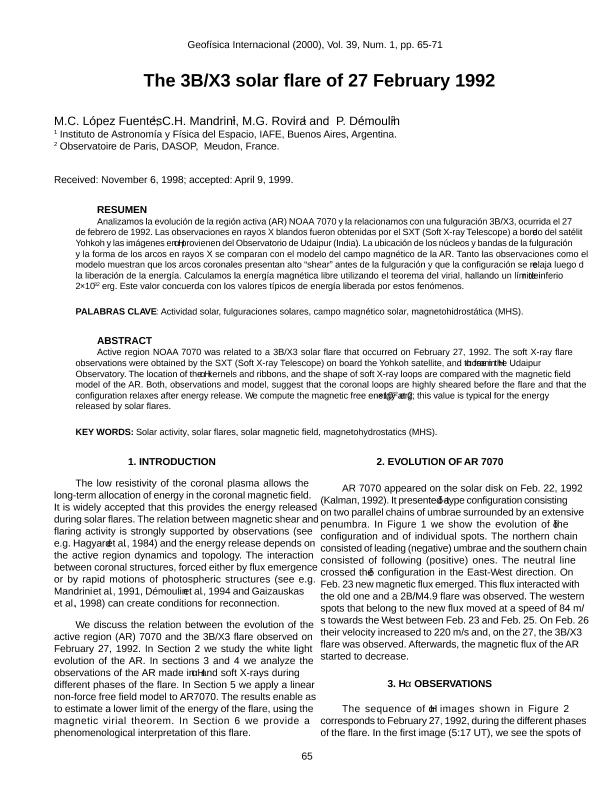Artículo
Analizamos la evolución de la región activa (AR) NOAA 7070 y la relacionamos con una fulguración 3B/X3, ocurrida el 27 de febrero de 1992. Las observaciones en rayos X blandos fueron obtenidas por el SXT (Soft X-ray Telescope) a bordo del satélite Yohkoh y las imágenes en Hα provienen del Observatorio de Udaipur (India). La ubicación de los núcleos y bandas de la fulguración y la forma de los arcos en rayos X se comparan con el modelo del campo magnético de la AR. Tanto las observaciones como el modelo muestran que los arcos coronales presentan alto “shear” antes de la fulguración y que la configuración se relaja luego de la liberación de la energía. Calculamos la energía magnética libre utilizando el teorema del virial, hallando un límite inferior de 2X1032 erg. Este valor concuerda con los valores típicos de energía liberada por estos fenómenos. Active region NOAA 7070 was related to a 3B/X3 solar flare that occurred on February 27, 1992. The soft X-ray flare observations were obtained by the SXT (Soft X-ray Telescope) on board the Yohkoh satellite, and those in Hα from the Udaipur Observatory. The location of the Hα kernels and ribbons, and the shape of soft X-ray loops are compared with the magnetic field model of the AR. Both, observations and model, suggest that the coronal loops are highly sheared before the flare and that the configuration relaxes after energy release. We compute the magnetic free energy at 2×1032 erg; this value is typical for the energy released by solar flares.
The 3B/X3 solar flare of 27 February 1992
Lopez Fuentes, Marcelo Claudio ; Mandrini, Cristina Hemilse
; Mandrini, Cristina Hemilse ; Rovira, Marta Graciela
; Rovira, Marta Graciela ; Démoulin, Pascal
; Démoulin, Pascal
 ; Mandrini, Cristina Hemilse
; Mandrini, Cristina Hemilse ; Rovira, Marta Graciela
; Rovira, Marta Graciela ; Démoulin, Pascal
; Démoulin, Pascal
Fecha de publicación:
01/2000
Editorial:
Instituto de Geofísica UNAM
Revista:
Geofísica Internacional
ISSN:
0016-7169
Idioma:
Inglés
Tipo de recurso:
Artículo publicado
Clasificación temática:
Resumen
Palabras clave:
Solar Activity
,
Solar Flares
,
Solar Magnetic Fields
,
Magnetohydrostatics
Archivos asociados
Licencia
Identificadores
Colecciones
Articulos(IAFE)
Articulos de INST.DE ASTRONOMIA Y FISICA DEL ESPACIO(I)
Articulos de INST.DE ASTRONOMIA Y FISICA DEL ESPACIO(I)
Citación
Lopez Fuentes, Marcelo Claudio; Mandrini, Cristina Hemilse; Rovira, Marta Graciela; Démoulin, Pascal; The 3B/X3 solar flare of 27 February 1992; Instituto de Geofísica UNAM; Geofísica Internacional; 39; 1; 1-2000; 65-71
Compartir



